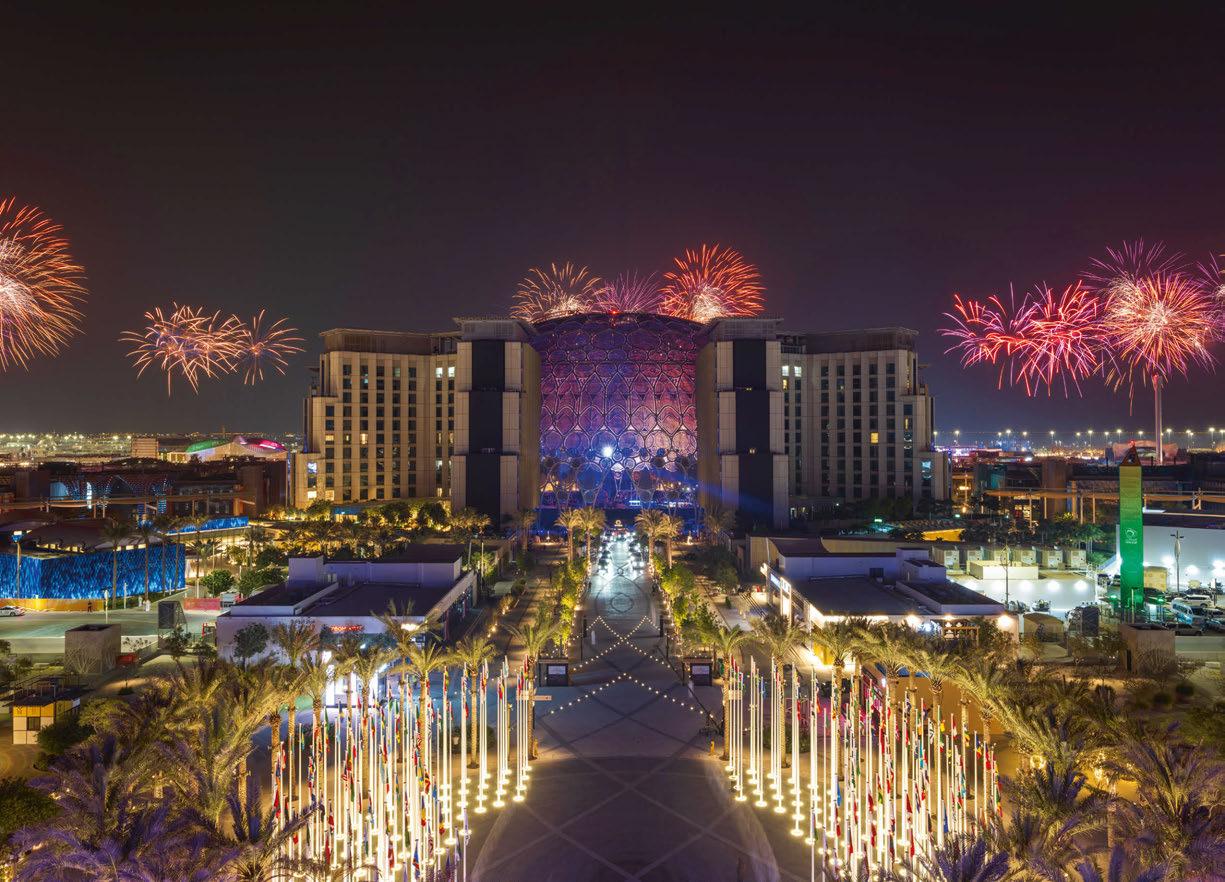
41 minute read
EXPO 2020 DUBAI SPECIAL
EXPO 2020 SPECIAL
EXPO 2020
22-PAGE SPECIAL EDITION ON ‘THE WORLD’S GREATEST SHOW’
THE MAN AT THE HEAD OF EXPO 2020’S EVENTS AND ENTERTAINMENT OFFERING DISCUSSES SOME OF THE COMPLEX PROCESSES THAT GO INTO OPERATING MORE THAN 3,000 PRODUCTIONS OVER A SIX-MONTH PERIOD.
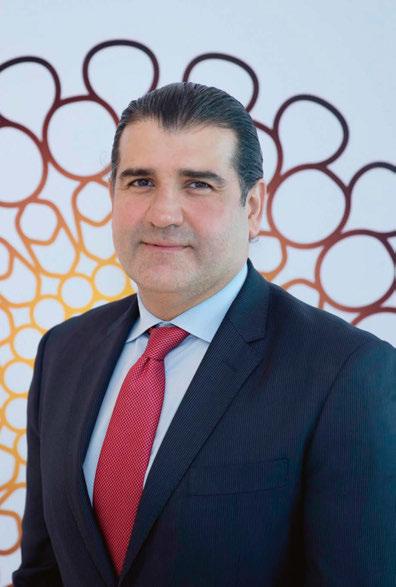
Hosting more than 3,000 performances over six months, the events and entertainment spaces at Expo 2020 are built to withstand the kind of rigorous schedule that would put even the world’s busiest arenas to shame. As well as a state-of-the-art technical setup and support from some of the best suppliers in the business, the purpose-built spaces benefit from an expert in-house technical team, charged with providing outstanding facilities and support to enable world-class shows to take place at Expo 2020 day after day. Tareq Ghosheh, Chief Events and Entertainment Officer at Expo 2020, is the man charged with overseeing all these elements and more. Here, he shares some insights from his journey so far, talks about the inner workings of Expo’s events and entertainment offering and speculates on the legacy that Expo 2020 will leave for the UAE.
What are the main events and entertainment areas on the Expo 2020 site? The main performance area is Al Wasl, which hosted the Opening Ceremony and will host the Closing Ceremony. It also hosts a daytime show called ‘music in the garden’, as well as nightly shows. We have the Jubilee Stage, which is a rock ’n’ roll, music festival-style stage, while the Dubai Millennium Amphitheatre (DMA) is more suited for theatre and dance.
In addition to these, we have three smaller district stages, designed to accommodate smaller performances with fewer on-stage performers. We also have an enclosed hall in the exhibition centre, which is great for conferences. Further to that, most of the public areas across the site are spaces for roving and musical acts.
How important was it to pick the best suppliers to help deliver the project? This is not a one-company kind of project. We worked incredibly hard to ensure that we brought on the right people for sound, lighting, projection, technical design, staging and so on. These suppliers are the very best in the world, who have helped us design the performance and entertainment areas in the best way possible.
One thing that we’re very proud of – and we think this could be the first time it has ever happened to this extent – is that we have some of the best technical and production
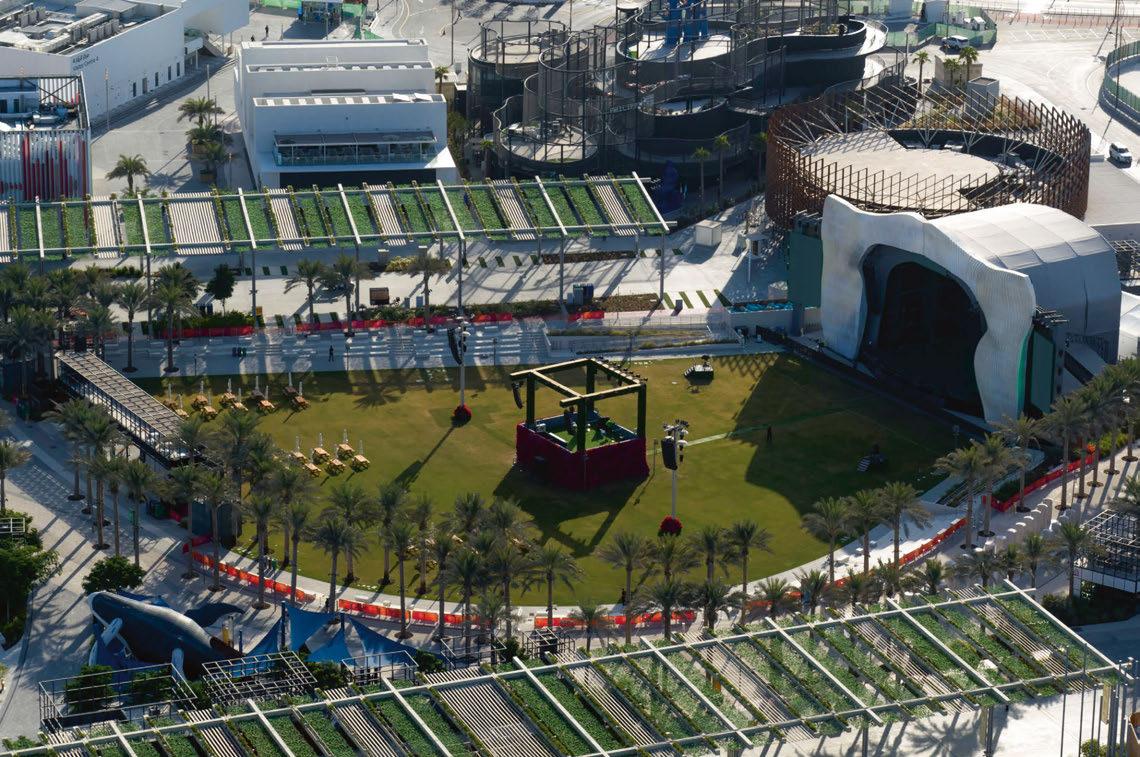
houses in the world working together all under one roof for a prolonged period during the planning, build and execution stages.
How did you go from concept to creation? The concept started from Al Wasl – which was originally an urban garden – and grew from there across all the other venues. The model for Al Wasl was expanded across the site in April 2020, so all the hard work we did in those initial stages paid off when we started rolling it out.
Of course, there have been ups and downs and plenty of challenges throughout the process, but we sit on the management of the dayto-day operations, and we guarantee that we always learn from our mistakes and maintain the integrity of the delivery throughout. I think this is very visible in the product that we are delivering now on a day-to-day basis. What is your process when putting a project out to tender? We use something we call the 80/20 model. What this means is that whenever we float any RFP, we ensure that we own 20% of the process. The first 10% is the creative conceptualisation, the technical validation, the operational optimisation, and the financial management. We give this to the production company for them to come up with a creative treatment and operational execution plan. We work with them hand in hand until the last 10%, which includes the excellence in delivery – it’s at this point that we jump back into the driving seat to ensure that what they are delivering is in accordance with what we planned and what we agreed throughout the process.
This is flipped completely when you look at it from a production and a technical point of view, where we own 80% and the supplier provides 20%. That guarantees a seamless delivery from a technical point of view, and as crews come in and out, the house team knows the landscape and the ins and outs of all the venues and the setup.
How are the performance areas set up to host such a huge number of performances back-toback, with limited changeover times? When you are operating in a living ecosystem like we are here at Expo 2020, it’s vital to ensure that you can provide world-class entertainment on a continuous basis, with very little provision for rehearsals or changeovers.
To achieve this, all our events and entertainment spaces are very different from what you would typically find on a regular house system. We looked at the components that we would need not only to increase efficiency and available performance time, but also to maintain
the integrity of the technical delivery and the ‘wow-factor’ of the productions.
Most of the venues, starting from Al Wasl, require minimal to no overlay to run a worldclass event. We have a state-of-the-art technical system in place, supported by some of the world’s best companies including Agora and Neumann&Müller, among others.
Then we have our in-house production team at Expo, which helps to keep together the three vital components – productions, show ops and technical – which will facilitate any creative execution in any of these fields. We will have more than 3,000 activations from international participants alone across our events spaces, which is a massive undertaking. So far, it’s working very well.
What have been your biggest challenges so far? Every day is a challenge, but one thing that we are particularly pleased with is that we came into a space that was designed by architects rather than event management consultants, and we have been able to turn it into an event-friendly setup that is capable of hosting world-class events with minimal disruption to what was already in place. We created back of house and logistics spaces that work for us and for the incoming acts, and we ensured that all event areas serve their intended purpose.

What aspects of Expo 2020 Dubai are you the most satisfied with? The level of pride in the country because of the quality of the delivery is extremely promising across the board, from top to bottom. We hope that we maintain that level and continue to meet the expectations of the leadership, to continue promoting the same narrative that Dubai and the UAE embodies in everything it does. We always push the limits, and we never give up.
What will the legacy of Expo 2020 Dubai be? The legacy is still in the making. Whatever was planned pre-COVID, needs to be altered post-COVID. However, we managed to put several landmarks on the map, which are now global landmarks that the world will look at and continue to be wowed by, day in, day out.
I’m sure that the leadership has a plan for this to happen and for this incredible space to continue to be a part of the story of Dubai and another representation of how you can get extraordinary things done, even in extraordinary situations like the COVID-19 pandemic. This has been a beautiful journey and I can’t wait to see where it takes us. Photos: Expo 2020 Dubai www.expo2020dubai.com
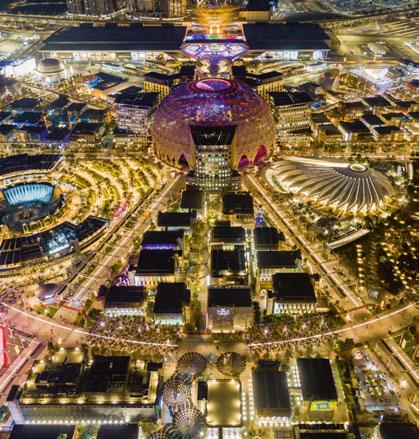

A Robust And Easy LED Display Solution For Outdoor Rental Solution

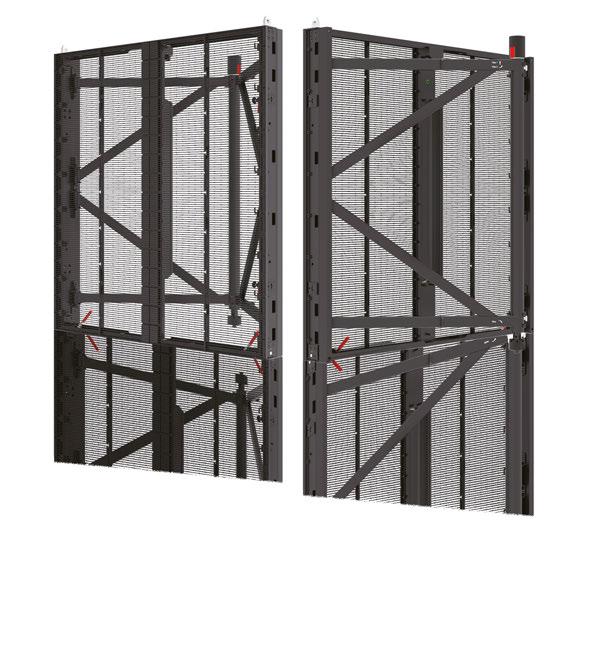
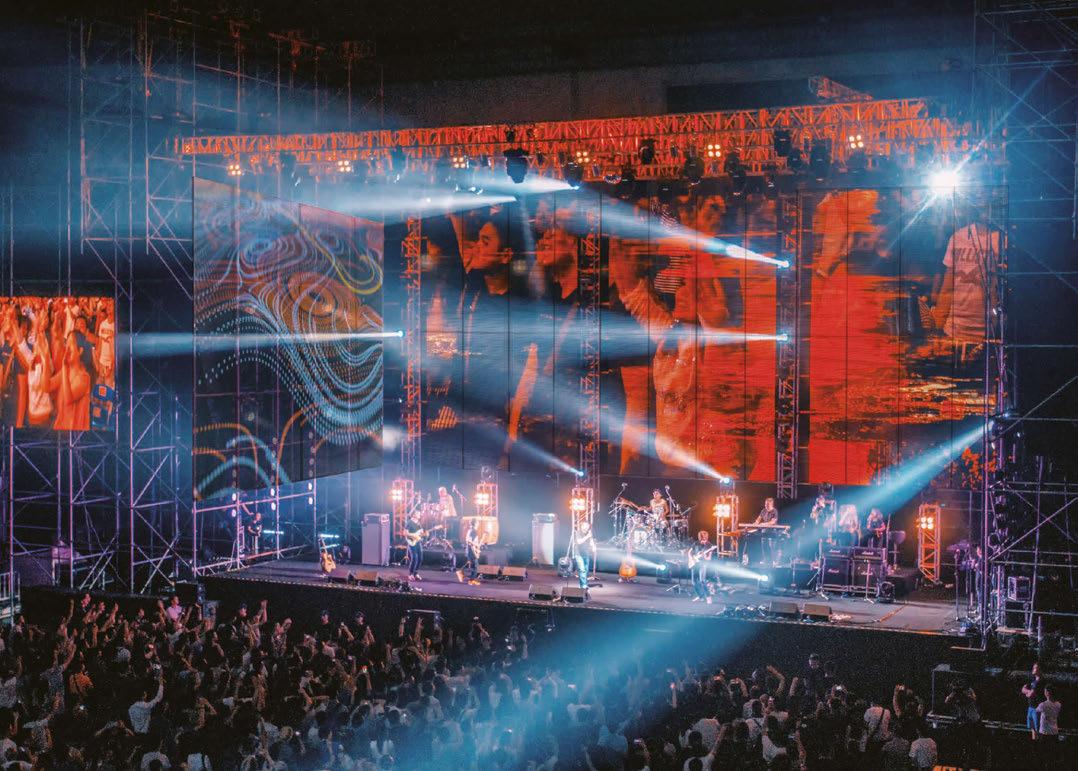
High Load Capacity High Load Capacity High Brightness High Brightness Quick Installation Quick Installation Easy Transportation Easy Transportation IP65 Protection IP65 Protection High Transparency Rate Of 70% High Transparency Rate Of 70%
PRG POWERS UK PAVILION WITH CUSTOMISED LED TILES
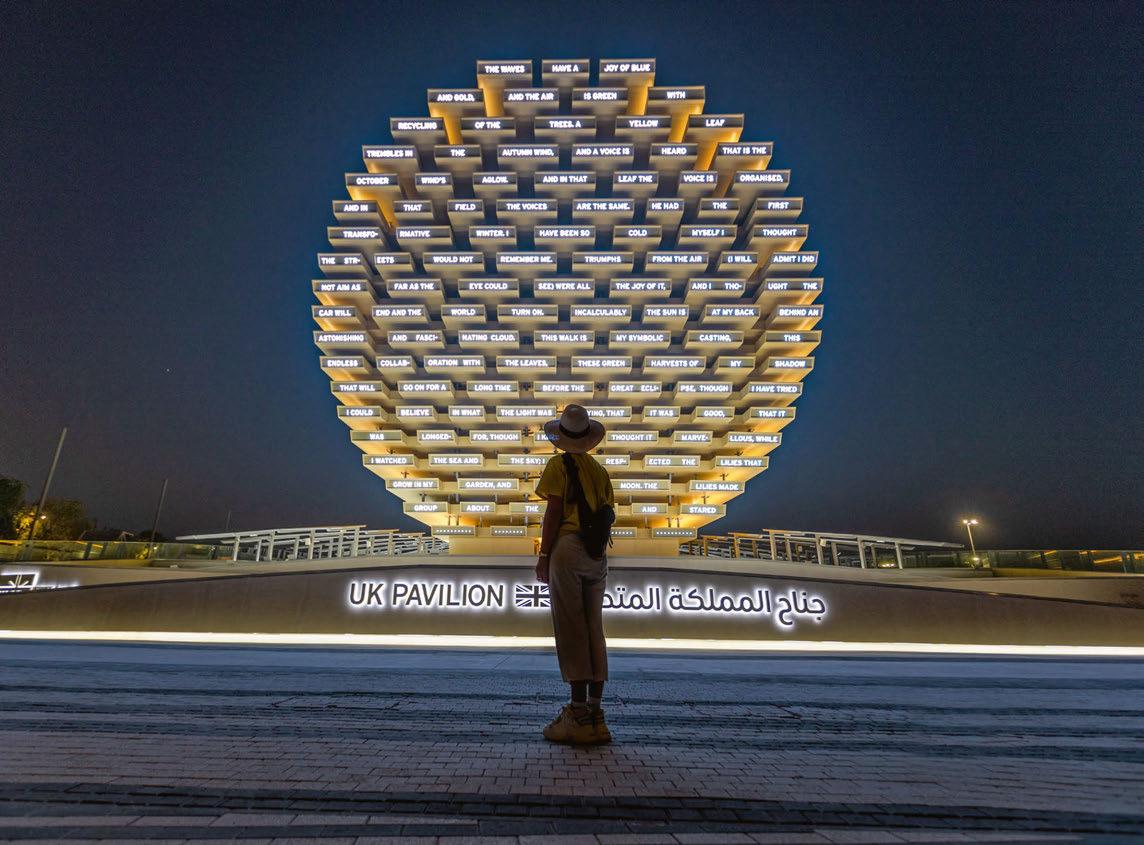
PRG TEAMS FROM BELGIUM, CHINA, THE UK AND THE UAE COME TOGETHER TO FULFIL A CHALLENGING BRIEF AT EXPO 2020 DUBAI.
Created by world-renowned designer, Es Devlin, The UK Pavilion at Expo 2020 Dubai is one of the most recognisable among the 192 countries represented on site. A mesmerising coneshaped structure with a 25m-high LED circular façade made up of 2,000 customised LED tiles, the pavilion uses an advanced AI learning algorithm developed in collaboration with Google Arts & Culture, which allows visitors to add their word to a continuously changing ‘collective message from humanity to the universe’ displayed on the LED modules.
PRG was appointed by Pico to deliver the engineering of the customised LED tiles through its PRG Projects team, which supported Devlin in her design process for the UK Pavilion, commissioned by the Department of International Trade and project managed by Avantgarde. Both the indoor and outdoor tiles use SMD LEDs, with the outdoor tiles coloured to match the building finish and the indoor tiles made from flexible PCB to follow the curved shape of the cassettes.
“We worked closely with our colleagues in Shenzhen to source the LED components and custom manufacturing,” PRG Projects General Manager, Frederic Opsomer told TPMEA. “Their presence in China was very helpful – especially when borders of the country were closed during the COVID-19 pandemic.”
PRG UK then supported PRG Projects in specifying the media servers and worked with the creative team from Luke Halls Studio on several demos to test the software. The entire R&D process took around six months from prototypes to the final product. Once the geometry of the building was decided, PRG Projects worked with its teams in Dubai, the UK and China to ensure the design and selection of LED was suitable for the conditions that are presented in UAE. “One of the main challenges was, of course, the conditions in Dubai,” said Opsomer. “We conducted several tests in climate chambers and mock-ups to ensure the products specified would perform across the duration of Expo 2020 Dubai.”
When it came to the on-site delivery, PRG Dubai led the team as the local contractor and installation provider, with a team of eight specialist technicians overseen by a project manager installing the LED tiles as well as the customised immersive audio system, designed by Polyphonia, over a six-week period. PRG Dubai

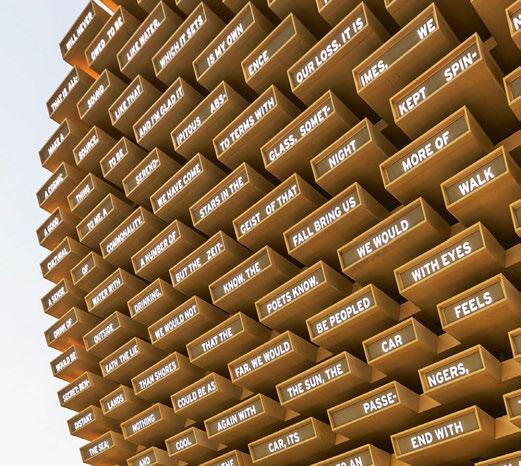

Senior Technical Project Manager, Gavin Short explained: “The soundscape is fed through a series of small speakers concealed within the cone, providing an immersive sound experience for the guests. The system is played from Q-Lab and triggered by the video control servers.”
Another challenge was the integration of the electronics into the limited space within the cone. “Our team worked with the design team and architects to ensure enough ventilation was factored in during the design and build,” Short said, praising the collaborative process. Opsomer added: “Being able to draw upon our team’s knowledge, resource and delivery across the group during the pandemic highlighted our strength in delivery. Despite being unable to travel, our teams were able to work across borders and time zones to find the technical solutions that were required to fulfil the design process and delivery onsite.”
Describing the project as “one of the most remarkable” he has ever been involved with, Opsomer concluded: “I have known Es for many years, and we have collaborated on several projects together. She is an amazing designer, and this project reinforces her already stellar reputation. This breath-taking design of evermoving poetry, displayed digitally and integrated to illuminate the façade of the UK Pavilion, was a beautiful challenge for us at PRG, and we are very proud to collaborate with her on this journey of innovation.”
Short concluded: “The UK Pavilion is an exceptional and unmissable part of the overall Expo experience, located in the Opportunity District and is clearly a space that will inspire visitors to the site.” Photos: Alin Constantin Photography www.prg.com
GENELEC SHOWCASES LOUDSPEAKER TECHNOLOGY AT FINLAND PAVILION
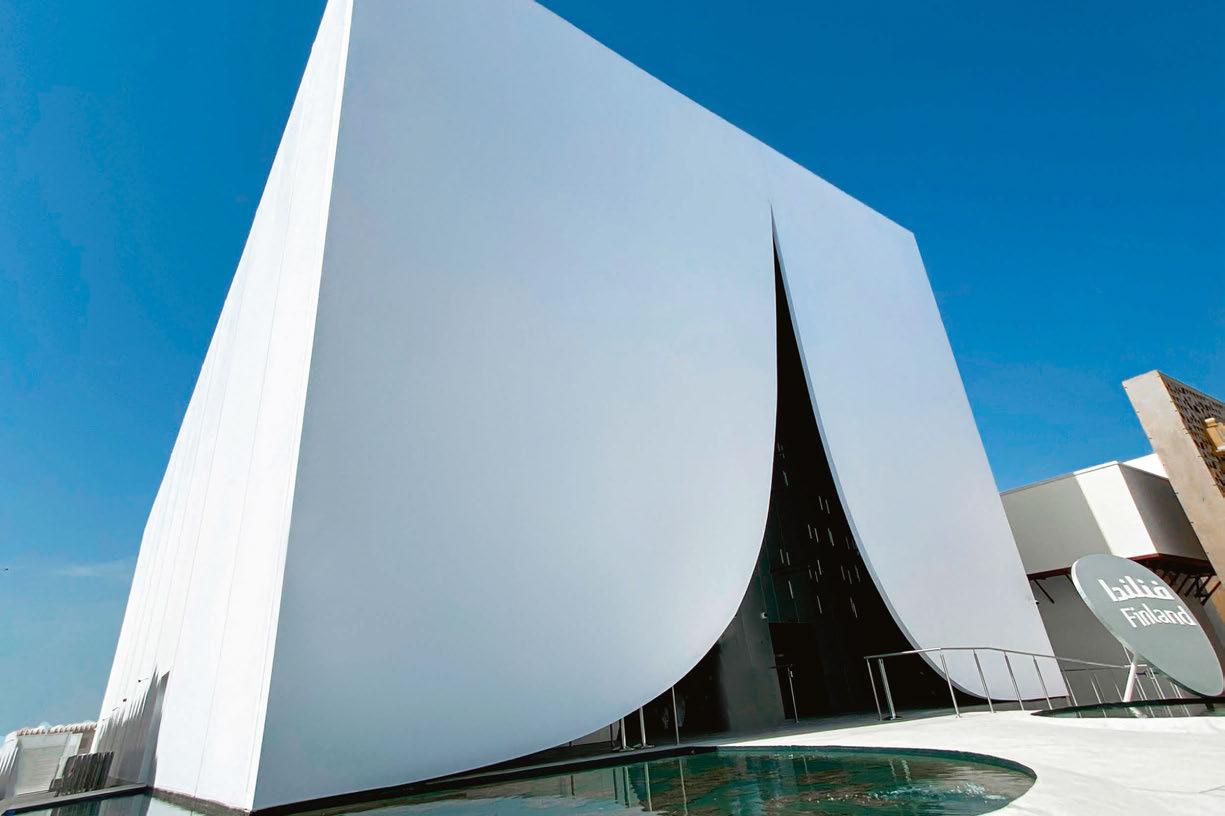
GSL PROFESSIONAL AND AUDICO SYSTEMS DEPLOY GENELEC 4430 SMART IP INSTALLATION LOUDSPEAKERS AT SNOW CAPE PAVILION.
Genelec has joined forces with Business Finland to showcase its Smart IP networked loudspeaker technology at Finland’s Snow Cape Pavilion at Expo 2020 Dubai.
A total of 84 Genelec 4430 Smart IP loudspeakers are incorporated into the pavilion, including a 10-channel immersive loudspeaker array that reproduces specially commissioned sound art by Finnish composer Emilia Takayama, entitled The Land of Snow.
Seventy-four 4430 Smart IP loudspeakers have been installed in the pavilion’s exhibition area, configured as a custom immersive array, while the other 10 4430s are handling The Land of Snow sound art content in ‘The Gorge’ area of the Expo 2020 Dubai building. The entire system is fed via Dante and powered using standard PoE+ network switches, and was designed by Genelec and commissioned by GSL Professional in Dubai, Genelec’s local distribution partner. The system installation and programming were handled by Audico Systems from Finland. Photos: Genelec www.audico.fi www.genelec.com www.gslprofessional.com
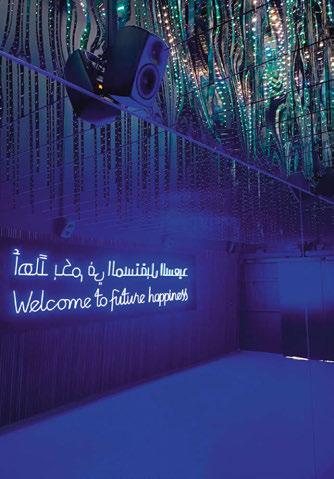
INFILED LED STARS AT FINLAND PAVILION
JKMM ARCHITECTS ENGAGES DXB LIVE FOR THE INTEGRATION OF TWO INFILED DB3.4MM LED DISPLAYS.
Two curved INFiLED DB3.4mm LED displays with a total size of 104 sq m have been installed at the Finland Pavilion at Expo 2020.
JKMM Architects engaged DXB Live for the setup and integration of the system, and the two companies worked together to create a cuttingedge, seamless curved LED solution that fits to perfection the theme, technical specifications, and overall impressive design of the pavilion.
“To achieve and ensure the requested seamless curve, our R&D team customised our standard DB cabinets to eight different curving angles including the hanging bars,” commented INFiLED Regional Sales Manager – Middle East, Samer Otaibi. “Creative installations are in our DNA, and we are delighted to see the result and be part of this impressive project among others at Expo 2020.” According to Otaibi, one of the main challenges was that the screens had to be hung from hanging bars, which required a lightweight, robust, yet high-quality product.
“DB series is easy to install, and features exclusive black LEDs offering vivid colours, high contrast and stunning image quality,” he added. “We’re very proud of this project, which will impress thousands of visitors.” Photo: INFiLED www.infiled.com
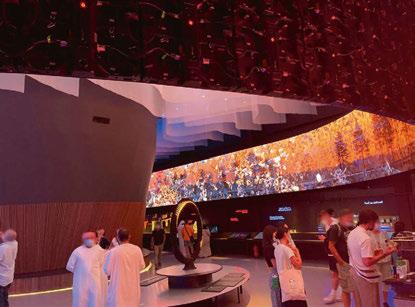

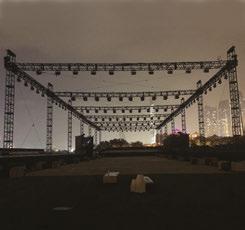
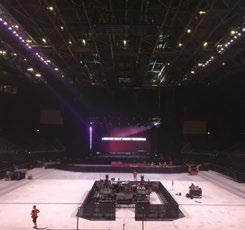

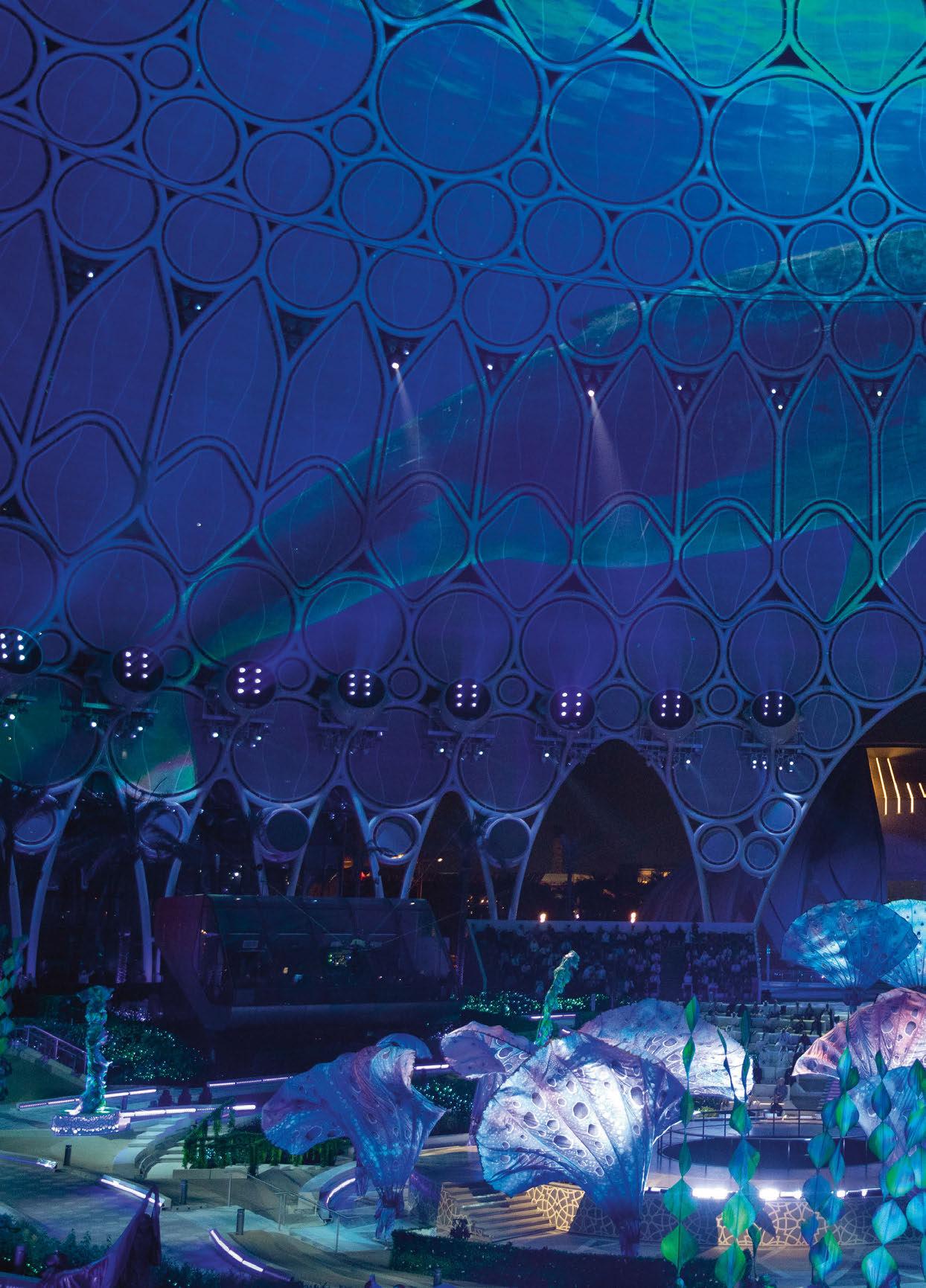
EXPO 2020: EVENTS AND ENTERTAINMENT
THE VERY BEST OF THE GLOBAL LIVE EVENTS INDUSTRY COME TOGETHER TO CREATE SPECTACULAR FACILITIES CAPABLE OF HOSTING ‘THE WORLD’S GREATEST SHOW’.

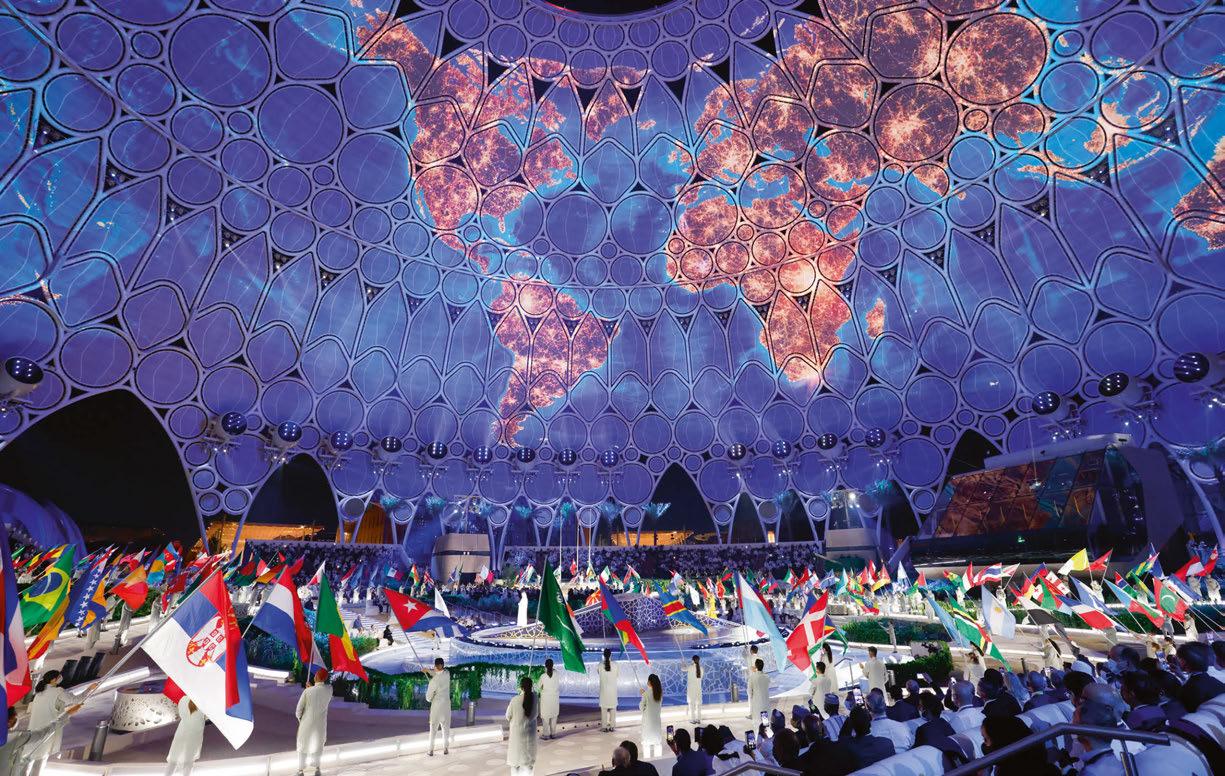
With the aim of ‘connecting minds and creating the future through sustainability, mobility and opportunity’, the remit for Expo 2020 Dubai is both ambitious and far-reaching. As well as original and innovative pavilions offering immersive cultural experiences from each of the 192 participating nations, the Expo site is also flush with events and entertainment areas, showcasing everything from opera and theatre to national day celebrations, parades, and concerts from A-list stars.
The main performance areas on the Expo site are Al Wasl Plaza, which hosted the Opening Ceremony; the Jubilee Stage, which is tailored towards music-based shows or festivals; and the Dubai Millennium Amphitheatre (DMA), which is geared towards theatre and dance performances. When it came to designing and building these areas, no time or expense was spared, with Expo 2020 Chief Events and Entertainment Officer, Tareq Ghosheh travelling all over the world in search of the perfect partners.
One such partner was Wonder Works, led by Piers Shepperd, which was appointed as Technical Consultant for the events and entertainment areas. “Piers played an integral role in the journey,” Ghosheh recalled. “He was the second person who I met when I started my journey on how to make this happen, and ever since, he has been an extremely insightful resource. He and his extended team have been an important part of our wider team.”
Wonder Works’ initial role was in developing the technical design and co-ordinating the technical systems for Al Wasl. However, the remit expanded rapidly into developing concept designs for other stages and venues across the Expo site. These concept designs were then turned into detailed packages with scopes and specifications, which were used as the basis for many of the technical contracts.
“We started working on Expo in early 2019, with [Production Manager] Rebekah Hanbury, one senior CAD designer and I supporting the EVE team in Dubai,” Shepperd revealed.
“The scope kept increasing as the scale of the project became clear. Our ambition was to create fantastic entertainment across the site in multiple venues every day that Expo is open – that requires a huge amount of planning and design capacity. We rapidly increased the team and, for several months of 2020, we had all nine of our employees and several freelancers working full-time on the project.”
As the scope of the project increased, Wonder Works Co-Director, Jeremy Lloyd, became involved. “Jeremy tends to focus on technical coordination and design for music touring events – Ed Sheeran and Roger Waters, for example – but as the scope expanded to include the Jubilee Stage and Dubai Millennium Amphitheatre, as well as the three district stages, Jeremy took on the former whilst Ben O’Neill dealt with DEC Hall and the district stage design,” Shepperd stated. “I remained overall project lead and continued overseeing Al Wasl and DEC Hall with Rebekah. Jeremy and I are both used to running multiple projects in parallel, and we have a really talented and enthusiastic team with support from a small team of freelancers.”
Shepperd’s team worked with EVE on the outline concepts for each stage. “Once these concepts were approved, we quickly moved into the detailed design and engineering, before creating the RFP packages for the various contractors,” he explained. This process involved a series of designs in 3D AutoCAD and Rhinoceros to present renders, 3D CAD drawings and
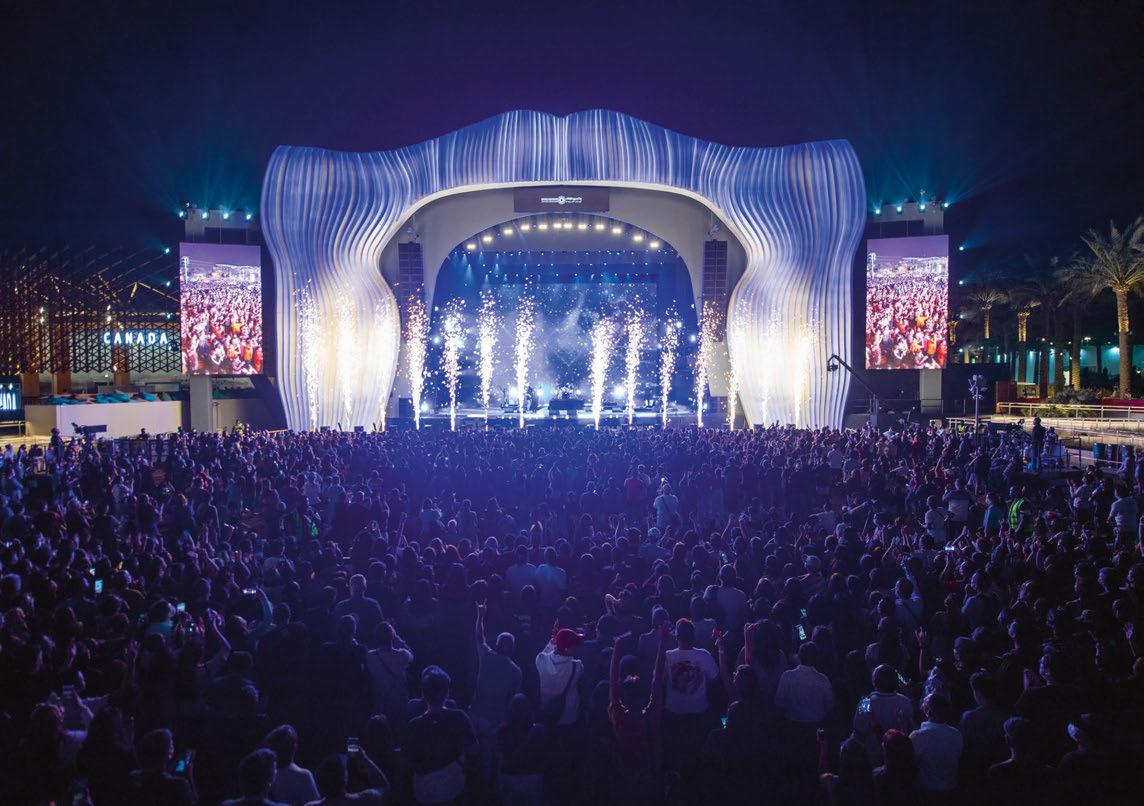
composited photos. “Ben O’Neill did a 3D laser scan survey of each venue using our Trimble SX10, which allowed us to have great visibility and understanding of how each object would integrate within the site.”
With each stage going through more than 400 iterations, all with detailed drawings and technical information, Shepperd described the process as a “colossal piece of work”.
He added: “The contractors commented on the great technical detail they were getting in the packages. This means contractors can bid confidently and competitively. There was a very clear mandate from Tareq to deliver something that was world class,” he said. “The senior EVE team were supportive of the production process, and it has paid off, because you can walk into any of the venues and see a top-level production supported by excellent technical infrastructure.”
Led by Ghosheh, the senior EVE team comprised: Executive Creative Director, Amna Abulhoul; Production & Operations Vice President, Kylie Mcomish; Ceremonies and Programming Vice President, Kate Randall; and Technical Vice President, William Ainley. “Tareq has assembled an extremely strong and focused team,” Shepperd stated. “Although he sets very high standards, he acknowledges that creating world-class entertainment takes work and he is realistic in his expectations.”
‘THE FULL GAMUT OF SKILLS’ Delving into a few specific highlights, Shepperd recalled the challenges of working on the DMA and Jubilee stages. “Both of these stages allowed us to show the full gamut of skills that we have at Wonder Works,” he stated. The most prominent scenic feature of the DMA is a large ghaf tree (the national tree of the UAE), which winds its way around the proscenium arch above the stage.
“For the DMA, we worked closely with Amna to refine the concept and then commissioned renowned sculptor, Jacqueline Pyle to make a scale model of the ghaf tree. We then took a 3D scan of the tree model, scaled up to full size, and engineered the façade structure to support it.” On the ground, Rebekah Hanbury’s broad role covered everything from production management to creative lead on the stage delivery, supporting the Expo 2020 Creative team.
Wonder Works Staging Manager, Nick Evans worked closely with VK Exhibitions Decor Industry (VK), who supplied the tree, as well as Al Laith, who supplied the stage and roof, to ensure that the design could be delivered to site on budget and on schedule.
VK General Manager, Nilesh Kariyal looked back on what he described as an “intense” process. “In the early stages, we had to convince the creative team that we would be able to produce something that looked realistic,” he commented. “We created the tree from fibreglass, and the final appearance and texture was exactly what the client was looking for.”
Dubai-based VK was also engaged to supply scenic work for the other stages. “We worked very closely with Wonder Works and the creative team from Expo,” Kariyal revealed. “The Jubilee Stage was another great success. We managed to achieve a beautiful mother-of-pearl finish to the façade that at first didn’t seem possible.” In the end it was VK Managing Director, Radheshyam
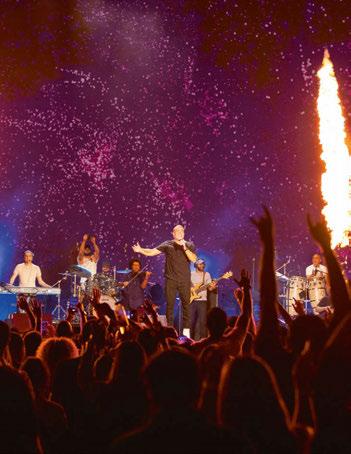

Jangid, who came up with the solution, which involved making a mould from CNC-cut plywood, then adding fibre coating, before applying the final finish. “It turned out very well, which is great, because the Jubilee is one of the most happening stages in Expo that everyone is talking about.”
According to Kariyal, Wonder Works lived up to its name on this project. “This was our first time working with Wonder Works directly and their team was wonderful, getting involved in the process at every stage and understanding that what we were trying to achieve takes time and effort,” he said. “After this experience, we would be one of their preferred partners in future work they do in the UAE.”
Wonder Works Production Manager, Rebekah Hanbury was equally effusive in her praise of the VK team. “They have been impressive from the beginning,” she said. “Some of the 3D machining work they took on was very complicated and they handled it excellently. It’s been an open collaboration and quite a journey, and we’ve been happy to support them.” With VK, as well as Al Laith and Unusual Rigging (which handled all the production rigging across the events and entertainment venues) all contributing major elements to the events and entertainment spaces, it’s clear that the onus has been on appointing suppliers that are either based in Dubai or at least have a UAE presence where possible. “It’s hugely beneficial for us to work with local suppliers because it means everything is much quicker, more cost effective and sustainable,” Hanbury reflected.
Shepperd added: “It’s part of our philosophy not to always work with the same companies; our clients get to decide who they want to use through procurement. Part of the legacy conversation around Expo 2020 must be that a major part of the money that is being spent by the UAE goes to suppliers locally, and that has been true – particularly on the staging and rigging side of the project. Not only is it better from a sustainability standpoint, but it’s also an opportunity for those companies to supply a world-class event in their own backyard.” Kariyal concluded: “We have developed a great relationship with both the Wonder Works and Expo team, which is built on trust. Being a local contractor, it’s hugely satisfying. We’re glad that we were trusted with the project, and we have not let them down.”
‘FLEXIBILITY AND RESILIENCE’ Each of the events and entertainment spaces is equipped with a top-of-the-line technical solution that, according to Expo 2020 Vice President Technical – Events and Entertainment, William Ainley, will more than meet the requirements of most incoming productions over the course of Expo’s six-month running time.
“The overarching ethos of our approach to delivering a technical solution in all of these spaces was to work with technical consultants from around the world to help us to come up with a hybrid house system to support at least 90% of incoming productions,” he told TPMEA. “We knew that this would be over-specified for most of the programming, but it means
Need help bringing your show to life?
Entertainment management that delivers the full package from page-to-stage.

Talent Booking | Full Show Production Creatives | Show Callers | Stage Management
w: weareenergie.com | e: hello@weareenergie.com @weareenergie
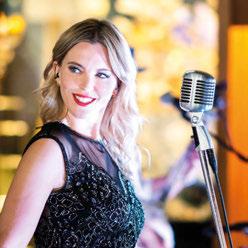
that there will be some flexibility and resilience in the spaces.” The main idea throughout the specification process, Ainley explained, was that incoming productions and agencies would be able to come into each space and everything would be up and running, ready to use.
“There’s very little in the way of transition time, resets and strikes required because we need to maximise not only the event time in the spaces but also the rehearsals as much as possible,” he said. “We’ve got a vast scope of programming across the six months, so it’s really just making sure that people can come in and they’re going to have near enough everything that they need already there for them so they can concentrate on delivering their event.
“The way that the delivery is structured across each of our stages and spaces is that a delivery agency sits above the technical teams,” Ainley continued, describing the operational structure. “We’ve engaged with international and local production houses and promoters to take on the turnkey responsibilities for delivering each of these stages and spaces.
“They also take on the responsibility for the planning of all of the events that are coming through those spaces, including the validation of technical riders, making sure that they align with the house system and if they don’t, then they allocate, and traffic manage the planning around making sure that these productions are coming through fully supported.” With such a packed schedule, overnight transitions are vital. “That’s the best way to maximise the potential of our daily programming,” Ainley described. “Most of the systems are already here in house and readily available, so we can make sure that all our overnight transitions are about the incoming productions getting the opportunity to assimilate themselves into the space, do their final stages of programming and rehearsal.”
This is all backed up by a set of WYSIWYG suites for each of the primary stages and spaces. “We also have a couple of audio suites in Al Wasl, which allow us to do the pre-programming before anyone arrives on stage,” he added. “It’s a standard operating system but on a larger scale.”
So far, the intention that 90% of incoming productions would be able to fit within the house systems has been achieved. “We have had around only 5% to 7% of productions that have required an uplift in some way, shape or form,” Ainley reported, adding that in most cases, the additions have been for elements like an orchestra, which requires more backline. “It’s all about trying to find efficiencies in making sure that these transitions and additions happen on an act-by-act level, which makes it a lot easier to manage the programming throughout the day.”

AL WASL PLAZA The beating heart of the Expo site is Al Wasl Plaza – a huge domed trellis structure measuring 130m in diameter and 67.5m in height, equipped with a fully integrated 360° immersive projection surface, as well as an extensive lighting rig and booming audio system.
The projection system features 252 Christie D4K40 RGB laser DCI projectors, which are housed within 42 projection pods. Inside each pod, six projectors are split into two discrete video channels, with the three projectors for each channel converging for increased brightness and redundancy. As well as the projectors, each pod contains a Thinklogical Dual Channel Fibre RX, two DVI distribution amps and a Ubiquiti EdgeSwitch 16. In addition to that, some of the pods contain Panasonic AW-UE150K PTZ, BirdDog 4K HDMI and disguise OmniCal cameras, as well as a Ubiquiti UWB-XG Wi-Fi BaseStation and a Riedel Bolero antenna.
The immersive experience is further enhanced by 27 audio arrays, each comprising 16 L-Acoustics KIVA II, as well as six subwoofer arrays of four KS28s, housed in bespoke speaker pods. L-ISA takes care of the signal processing and placing of the audio ‘image’ within the space. The specialist workflow necessitates the provision of two scaled-down versions of the 27.1 channel system to provide pre-production and content validation facilities in-house, on site.
Content is controlled from the basement level, with a packed equipment room featuring an arsenal of 16 disguise gx 2 media servers, as well as the Thinklogical video matrix, CMS, centralised network, and other back-end equipment
SAVE THE DATE 11TH MAY 2022
For more information contact Justin Gawne: j.gawne@mondiale.co.uk or Fran Begaj: f.begaj@mondiale.co.uk www.tpmeaawards.com
required for the system to operate. The gx 2s are split into three categories to ensure highavailability video playback. Two are ‘directors’, 11 are ‘actors’, and three are ‘understudies’. The directors are used to control the actors and create new shows, while the actors are used for media playback and connected to the 84 projector outputs, leaving one channel dedicated to the trellis LEDs. The understudies, as the name suggests, are on standby to be promoted into the place of the actors in case of any issues.
A NewTek IO system allows physical inputs to be patched into the disguise system, routed via NDI, for subsequent picture-in-picture display on the projection. There are Barco ImagePro 4Ks in this loop to allow for signal conversion or scaling of the content prior to it reaching the NDI stream.
Creative Technology Middle East (CTME) was awarded the AV integrator contract to provide the installation of both projection and audio. There are 2,685 LED SACO V-PIX 8s embedded into the trellis structure itself to further enhance the immersive effect.
The venue contains similarly impressive lighting and audio overlay systems, designed by Woodroffe Bassett Design’s Adam Bassett and Auditoria’s Scott Willsallen, respectively.
With Al Wasl Plaza featuring numerous performance areas, the lighting setup is a world away from the standard rock ’n’ roll-style rig. A total of 28 Robe MegaPointe and 73 GLP impression X4 Bar 10s surround the main stage, with a further 24 MegaPointes and 24 GLP impression X4s available as deployable floor equipment, and 24 Vari-Lite VL10 BeamWash fixtures on rolling carts to be used as required.
Ayrton fixtures are a feature of the setup, with a main truss of 14 Perseos equipped with Follow-Me performer tracking, combined with lighting towers of 32 Domino and 16 Shamal fixtures (also with Follow-Me). The upper section of the trellis is adorned with 106 Elation Professional Proteus Maximus profile fixtures, with 53 of the same fixtures covering the bottom. The projection pods meanwhile utilise 82 more Proteus Maximus, as well as 84 SGM P-5 TWs, 168 Ayrton Pereos and 84 Dominos.
The B stage, dubbed ‘Stage of Nations’, is designed to host the National Day ceremonies and cultural performances for each of the participant countries. This features its own inbuilt lighting, with four Studio Due Par LED 300 Pro RDMs, 12 Terra Plus M RDMs and 33m of LED Flex Duro Flex RGBW60 built into the stage.
The performance areas are surrounded by gardens, which are lit by over 30,000 bespoke LED and strobe fixtures.
Atmospheric effects are provided by eight MDG ATMe haze generators, eight theFANs, and four theONE stadium hazers, while the whole system is controlled by an MA Lighting grandMA3 full size console, with a grandMA3 light console on hand as backup. The main stage L-Acoustics stereo audio system comprises six flown arrays of four A15 loudspeakers and four KS21 subwoofers; plus two flown arrays of three A10 loudspeakers, all hanging from a circular overhead truss; 24 SYVA loudspeakers, mounted on custom poles around the perimeter serving as delays to the central PA; two further SYVAs mounted on custom poles serving as a portable audio system as required; and 36 X4i loudspeakers built into the central Al Wasl stage as front fill.
Two DiGiCo SD7 Quantum consoles equipped with Waves SoundGrid Extreme Server C DSP units and running a Rational Acoustics Smaart v8 Acoustic Management System control the mix from FOH. The monitors system comprises two L-Acoustics 108P and two Neumann KH 120 loudspeakers, with two Merging Technologies Ovation playback systems, complete with Ovation Mass-core 128 Platinum licences.
A huge selection of microphones is on offer, including: Neumann KMS104, KMS105 and KM184; Shure SM57 and BETA 58A; Sennheiser E901, E902, E904 and MK4; and AKG C414. A Shure wireless microphone and in-ear monitoring systems are also in operation, with eight channels of Axient Digital, plus eight channels of PSM 1000 IEMs.
“The technical overlay has been really well considered,” said Shepperd, reflecting on the collaborative process. “You don’t see messy cables or miles of truss everywhere. You walk into Al Wasl and you’re not aware of one of the world’s largest audio systems hanging right above your head. It looks effortless, yet it’s taken a lot of
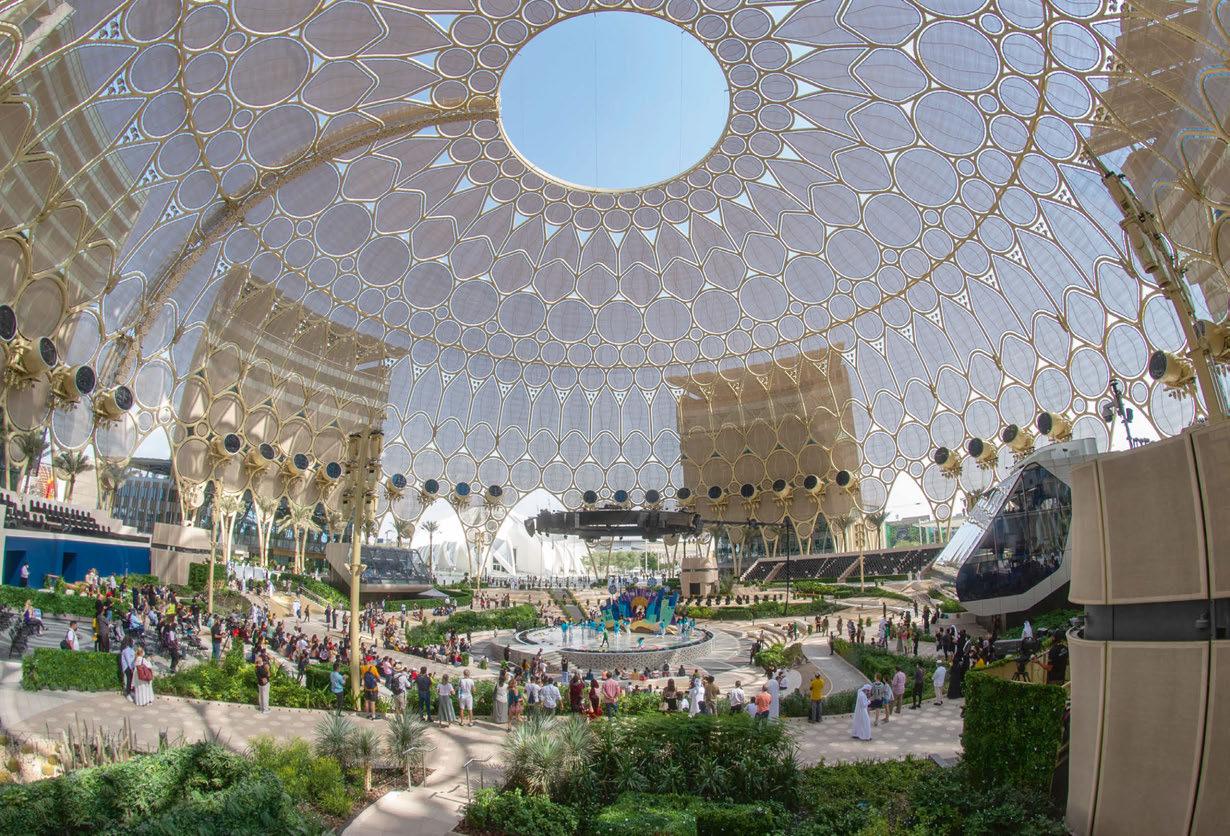
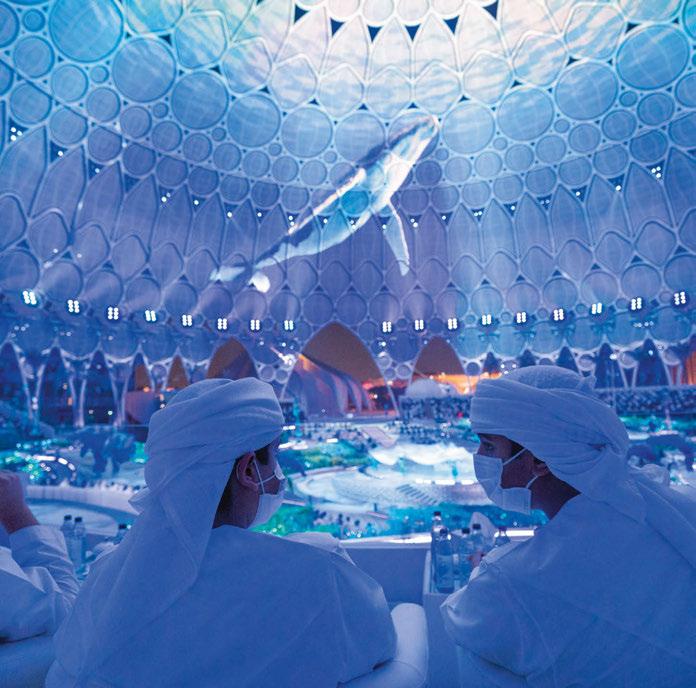

effort to get it looking that way – it’s a credit to everyone involved in the project.”
‘BUILDING SUSTAINABLY’ Stage One was responsible for manufacturing and installing a series of stage builds, including the central stage, incorporating a doughnut revolve and automated scenic traps, integrating with the house stage lift, a carefully considered overlay hoist system fully respecting the architecture of the trellis, plus numerous broadcast camera towers distributed within Al Wasl Plaza gardens.
Having worked on many large-scale shows over the years – including the UK’s awardwinning pavilion at Milan Expo in 2015 – it was a task that was well within the capabilities of the UK-based company. However, the real challenge, according to Stage One Managing Director, Tim Leigh, was designing a stage that would work not just for the Opening Ceremony, but for the six months of Expo and beyond.
“The main consideration from a stage engineering point of view was that we were designing something that is built to last, but we had to configure it to deliver against the creative intent of the Opening Ceremony, which hadn’t yet been finalised,” Leigh explained. “We also had to keep in mind that the daily shows would require something different, which hadn’t yet been determined either.” After being provided detailed concept drawings by Wonder Works, Stage One worked closely with the technical consultants, as well as various other stakeholders including Expo’s in-house teams, to find the best solution possible to satisfy both the technical and creative aspects of the scheme. “As people who serve the creative industry, we absolutely hate putting any constraints on a design,” Leigh noted. “We want our friends on the creative side to be free to be as imaginative as they wish.”
To achieve a durable build, Stage One experimented with a range of stage surface materials. The project required a material that would deal with extreme heat and humidity, could be painted with an intricate design, and that would withstand months of rehearsal then live performance traffic. Eventually, a rubberised compound that is traditionally used in sports halls was chosen. The compound was mixed and floated in layers to give an even finish.
Another challenge of the project lay in its location, under the world’s largest immersive projection dome. “We had to be particularly mindful when connecting our rigging to not interfere with or impact on the projection paths,” Leigh stated. “We made ongoing adjustments to our build to accommodate changes and tweaked cues and automation motion paths as things progressed in order to meet the show’s developing requirements.”
One scenic element Stage One needed to account for was a giant LED planet, which featured in the Opening Ceremony. Created by
OUR NEW SECRET
RECIPE FOR SUCCESS
A hint of saffron yellow, a dash of paprika red and... POOF! Every ingredient at your fingertips to create the perfect recipe. Mix any flavor of white or color to taste with FULL-COLOR-SPECTRUM LED fixtures from Elation.
KL PAR FC™ KL FRESNEL FC SERIES™
KL PANEL™ KL PANEL XL™
FUZE PROFILE™ FUZE WASH FR™ FUZE PENDANT™

UK-based show design studio, NEWSUBSTANCE, the planet was hoisted into position by nine winches and revealed by 28 automated hinged traps in the stage. “We know that the creative journey is always an evolution of sorts, and while there are always technical challenges associated with integrating new creative elements into an existing scheme, we’re well experienced at finding solutions,” Leigh commented.
Like most of the stages and platforms that Stage One builds, the 23m circular central stage was designed and manufactured in pieces so it could be assembled quickly once on site. The addition of curved ramps either side allow for performer access, and the doughnut revolve on the outer edge enables cast to be transported around the perimeter of the performance area.
With safety always a priority, a handrail was included, which rises automatically to protect performers from the deep central void. There’s also a touch of glamour, with the surface of the stage incorporating 2,400 individual 3mm RGB LEDs to create a starfield effect.
As well as the main central stage that now sits inside Al Wasl Plasa, Stage One created not one but two exact replicas, which enables rehearsals to take place in separate venues, leaving the main stage free to operate a full schedule of programming throughout Expo.
Commenting on the Expo site in general, Leigh praised the “high quality of execution” throughout. “It was fantastic to have a look around Expo and see what has been created,” he commented. “The Middle East is a very important market to us. The UAE especially is an extremely creatively driven nation that loves the spectacular. We’re proud to be invited back into the region once again and we are keen to continue working and building sustainably in the country in the future.”
‘THE DIVERSITY OF OUR PLANET’ With the stage set and the myriad systems set to go, the much-anticipated Expo 2020 Opening Ceremony took place on 30 September. Aside from the 3,000-strong audience inside Al Wasl Plaza, millions across the globe tuned in to view the eagerly awaited event.
Music from the likes of Andrea Bocelli, Ellie Goulding, Chinese pianist, Lang Lang and Saudi singer, Mohammed Abdu, backed by a beautiful live orchestra, combined with a cast of more than 1,000 performers and volunteers, and a sensory overload of powerful visuals beamed across Al Wasl Plaza’s dome, contributing to a spectacle of masterful artistic collaboration.
Scott Givens, Executive Producer, Expo 2020 Opening Ceremony and President of Five Currents, who co-curated and co-produced the show with Artistic Director, Franco Dragone said: “We picked artists that had songs that belonged in the ceremony and that tied in with Expo’s themes. We wanted to represent the world; to be plural, and to reflect the diversity of our planet. I’m proud of the combination of talent that we’ve brought together to do this and the way they’ve executed the story.”
After the spectacular, TPMEA caught up with Technical Director, Nick Eltis, who was brought into the project by Five Currents in April 2021.
“My first task was to wrap my head around the creative and get a handle on what had been agreed in regard to the physical build of staging and scenic,” he recalled, speaking from quarantine in his Sydney hotel room, having
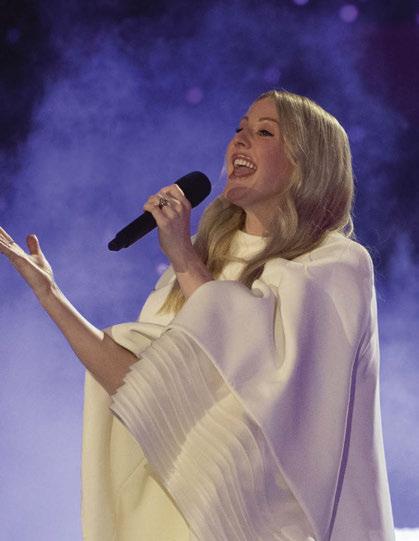
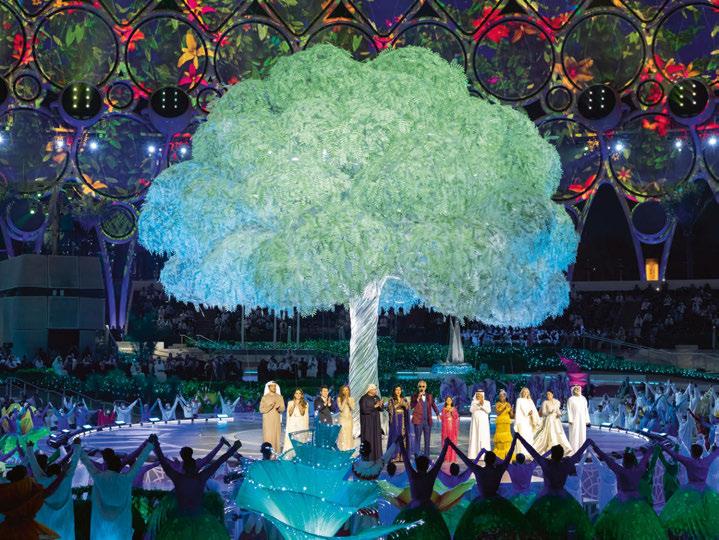
recently returned from Dubai to his native Australia. “The elements with a long lead time are critical and always the first things that need to be in place. Then all the other technology areas follow on from there.”
Having been involved with some of the world’s largest productions over the years, Eltis – who has worked with Five Currents for more than a decade – is well-versed in juggling the creative and practical sides of a project. “In parallel with the practicalities, it was also important to take stock of the creative at an early stage, assess what I think is achievable and tally that against what had already been agreed,” he said, noting the fact that he had worked with many of the team involved in the Expo project many times before helped speed the process along. “Those long-term relationships help with the shorthand of getting things done quickly.”
According to Eltis, the experience of working with the in-house Expo team was open and collaborative. “They had a large influence over the creative. After all, it is their show, and we are working to deliver what they want to show the world. It was important that they maintained that level of creative control. We ensured that they were engaged at all stages throughout the process, signing off on designs, samples, prototypes and then the final build.”
When it came to appointing suppliers, Five Currents has a stringent tender process. “We tender everything as part of our commercial due diligence,” Eltis revealed, explaining how the specialist knowledge of each individual supplier is crucial to the overall success of the project. “We come up with requirements, but we don’t necessarily dictate the specific construction methods, or provide a fully technically realised design package, because we would be missing out on the specialist knowledge of the people who build these things for a living every day. They may come up with better ways of doing it that we may not have thought of.”
The fact that the Opening Ceremony was the first event inside Al Wasl Dome and would be followed by six months of continuous events provided an extra challenge for the team. “We were the first of 183 days of shows, so we were testing the procedures and systems that were put in place for the long haul. Working in a venue that is designed to facilitate six months of daily consecutive performances rather than just one opening ceremony meant that we pushed the space and facilities to their maximum potential.”
Recalling some of his favourite moments from the show, he referenced the large LED planet. “That was particularly challenging because of the small area inside the stage that it had to emerge from and be packed back into. The guys at NEWSUBSTANCE did a great job at squeezing every millimetre out of it,” he said, adding that the team was able to make the planet look even more effective by figuring out a way to power it and trigger the content playback onboard. “It was originally supposed to have an ‘umbilical cord’, but I thought that it would look much better without. We got there in the end.” Another notable scenic element was an 8m-tall tree which, again, had to pack into an understage storage area of less than 3m.
Augmented reality was a feature of the broadcast, with UK-based Bild Studios collaborating on the project. Various elements such as waterfalls and butterflies were incorporated into the show design for the athome audience as well as VIPs in attendance viewing through local screens. “The technology for the AR had to be overlayed and integrated with the existing broadcast systems, with wireless tracking added to cameras and disguise servers handling the tracking and real-time rendering. The AR had to work in with the projection where we utilised the full resolution of 27K for the dome,” he explained.
According to Eltis, there was a conscious effort to broadcast the AR in 4K rather than HD. “Technical Manager, Greg Kershaw and I drove that,” he recalled. “Rendering the content at 4K at 50 frames per second in real time – particularly with the vines and waterfall effects – pushed the technology to its limit. It was monitored throughout the creation process and ensured that it never dropped below 50 frames.”
With the AR elements only visible to some members of the audience and the viewers at home, the creative team had to tread a fine line between utilising the technology to its full potential and not leaning on it too heavily for the narrative of the show. “It’s a change in
mindset because you don’t want to overuse the technology,” Eltis said. “The team needed to understand both the capabilities and limitations of the technology and be conscious of the fact that the content that was visible in the room needed to be engaging enough that it could stand up on its own without the AR elements.”
Overall, Eltis was pleased with the achievement. “The show was well received, and we were able to deliver a significant global event during what was an extremely challenging period for the whole world. It was hard work, but it was exciting, interesting and a great pleasure to be able to help the people of Dubai start their journey during the six months of Expo.” And while Eltis had only just got back to Sydney, he was already looking forward to returning to Dubai. “We’ve already started work on the Closing Ceremony and I’ll be back in Dubai to work on that in the New Year,” he concluded.
‘WHAT A GREAT BUNCH OF PEOPLE’ As well as the impressive show inside Al Wasl Dome, Five Currents contracted renowned fireworks choreographer, Eric Tucker to design a sitewide fireworks show, which was realised by Dubai-based FLASH ART. “Our scope on this project was purely technical,” began FLASH ART Senior Project Manager, Piotr Szablowski. “We contributed ideas of how to put Eric Tucker’s design into practice.”
The design saw five aerial shows with positions spread venue-wide, from the extreme left to the extreme right of the Expo site. “There were two clusters of positions on Ghaf Avenue, which runs through the middle of Expo, as well as three rooftop positions around Al Wasl Park,” he described.
While the setup and orientation of the fireworks was “quite simple”, according to Szablowski, the most challenging aspects of the project were “procedural”. He explained: “There were a lot of stakeholders, so accommodating all the various procedural requirements was a challenge. The creative concept had to keep evolving – as did our approach – practically until the day of the show.”
However, working with the Five Currents team was “an absolute breeze”. He added: “This was far from their first rodeo, and they accommodated all our requirements even better than we could have imagined or asked for. My lasting memory of the project is what a great bunch of people they are. They had a huge task with the Opening Ceremony, and they pulled it off in style.” Wonder Works’ Shepperd echoed Szablowski’s sentiments. “There is no getting around the fact that this is a huge project, and it is always going to take a considerable amount of time and effort to get approval from all the stakeholders, then work through with all the suppliers to make sure that they can deliver what is needed,” he explained. “Our role is sticking with it throughout this process.”
He concluded: “I’ve worked on large-scale events across the region and the world including several Olympic Games Opening and Closing Ceremonies, but the scale of ambition and production present across Expo is several times greater than anything I’ve ever come across. Typically, we work on a project for 18 months to deliver one ceremony or tour, whereas Expo delivers entertainment in seven multipurpose venues, day and night, every day for six months. It is a massive undertaking in planning and production, and we are extremely proud to have been involved.” Photos: Expo 2020 Dubai www.expo2020dubai.com www.fivecurrents.com www.flashart.com www.stageone.co.uk www.thevkgroup.com www.wonder.co.uk
